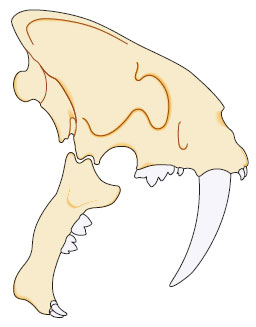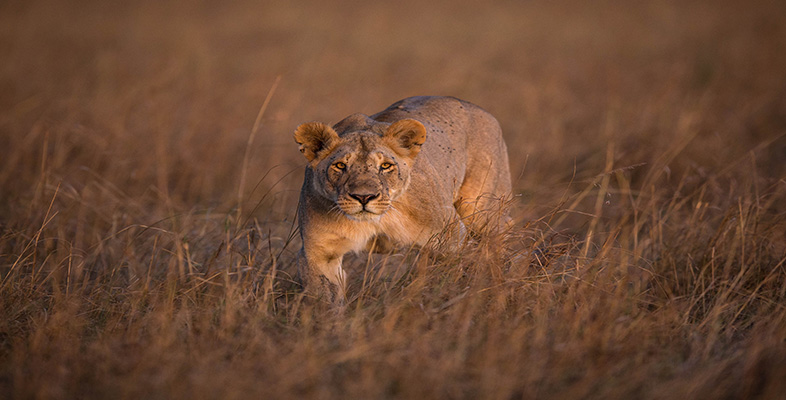2 The Carnivora
2.1 Introducing the Carnivora
Table 1 in this section lists the scientific names of the families of the Carnivora, as well as their common names. You are not expected to recall the family names, though you will probably be able to make links that enable you easily to remember some of them (K9 is a robot dog, Felix is a cartoon cat and Ursa Major is the constellation of the Great Bear, for example). The names can be quite difficult to pronounce too, but you need not worry about that. Often different scientists pronounce the words differently.
Earlier units in this series have highlighted the issue of the success of certain groups of mammals - for example, the herbivores. A useful starting point is to ask what features of meat eaters have made them successful.
SAQ 1
Question: From your general knowledge, earlier TV viewing and reading of LoM, as well as David Attenborough's (DA's) comments in the current programme, list as many features as possible that are needed for success in hunting.
Answer
I expect that you listed some of the following: strength, speed, keen senses, and methods of catching, killing, dismembering and digesting the prey.
The dictionary definition of a carnivore is simply a meat eater, but not all carnivores are mammals. Birds such as owls and hawks, many reptiles, amphibians and fish are carnivorous - as well as numerous invertebrates, ranging from insects such as the praying mantis, to molluscs such as certain squid.
However, in this course (and in LoM) the term carnivore is applied exclusively to those mammals that belong to the order Carnivora. The Carnivora comprise a natural group (i.e. are thought to have a common ancestry) and, as I'll describe later, they have particular anatomical features in common. The earliest recognised ancestors of all present-day carnivores were probably the miacids, forest dwellers of the Eocene, 50 million years ago. In some respects, miacids resemble modern-day genets and civets [pp. 141-142] but fossil evidence reveals adaptations for living in trees, i.e. they were arboreal. So in terms of lifestyle, they have features in common with modern-day carnivores such as the pine marten.
Activity 1
Watch the TV programme again from 04.16-05.31 and make notes on what features of the pine marten equip it for arboreal life.
Discussion
Most obvious are the semi-retractile claws which, together with large paws, provide the 'superb grip' on branches that DA refers to. As an agile tree-dweller, the pine marten is small, leaping impressively from branch to branch. Its bushy tail is a useful aid for balancing, but none of these features inhibit foraging on the ground where, as the programme shows, the pine marten picks up invertebrate prey.
During the subsequent Oligocene (34-24 million years ago) there was an evolutionary explosion in the variety of food plants and in herbivore species. During that time, predatory carnivores rapidly evolved into a range of new groups, able to exploit different conditions and available food prey. Some continued living in trees and others became ground-dwellers. As conditions changed, many of the largest ones became extinct - some in comparatively recent times. Those awesome predators, the sabre-toothed cats, survived until about two million years ago. Their fossil remains are best known because of the massive canine tooth on each side of the upper jaw (see Figure 1).

From the miacids may have evolved the carnivore families that we can recognise today, listed in Table 1. Just seven families are identified in the table, but some taxonomists think of civets and mongooses as sufficiently different to warrant their placement in different families, the latter comprising the Herpestidae. Sometimes the skunks are seen as a subfamily of the mustelids, as implied in Table 1; others argue that they should be accorded the status of a separate family (Mephitidae).
| Family | Examples | |
|---|---|---|
| Common name | Scientific name | |
| dogs | Canidae | African hunting dog, wolf, fox |
| weasels | Mustelidae | stoat, badger, ferret, weasel, otter, (skunks?) |
| bears | Ursidae | polar bear, brown bear |
| raccoons | Procyonidae | raccoon, coati, (giant panda?) |
| cats | Felidae | lynx, lion, tiger, leopard, cheetah, wild cat |
| hyenas | Hyaenidae | spotted hyena, brown hyena |
| civets and mongooses | Viverridae | civet, genet, mongoose, meercat |
Footnotes
This taxonomic scheme suggests seven present-day families of Carnivora, though some claim the total is nine. The status of the giant panda within the Carnivora is uncertain; most taxonomists place it in the bear family, but some claim it is closer to the Procyonidae - a family you'll read more about if you study the next course in this series. It is generally agreed that the Carnivora can be divided into two groups (or 'great tribes', as DA refers to them in the TV programme) - the feliforms and caniforms - cats and dogs.SAQ 2
Question: Using the index in LoM, identify which of the species listed in Table 1 feature in Chapter 5.
Answer
Many do: African hunting dog [p. 136], (grey) wolf [p. 130], arctic and fennec fox [pp. 129 and 135], stoat [p. 126], lynx [p. 149], lion [p. 152], tiger [p. 149], leopard [p. 150], cheetah [p. 151], wildcat [p. 155], brown hyena [p. 143], civet [p. 142], genet [p. 141]. Neither the mongoose nor the meercat is mentioned in LoM (though the latter features memorably in the TV programme 'Life in the Trees'); the polar bear, brown bear and racoon are mentioned in LoM Chapter 6, as is the giant panda.
So, a number of Carnivora are not primarily meat eaters - you'll encounter them if you work through the next course, S182_6 Studying mammals: the opportunists. For example, although the giant panda occasionally eats insects and small prey, it is for good reason called the 'bamboo bear'. Clearly, in defining mammalian carnivores, we have to turn to other diagnostic criteria.
